Add this eBook to your basket to receive access to all 155 records. Our indexes include entries for the spelling scarth. In the period you have requested, we have the following 155 records (displaying 111 to 120): These sample scans are from the original record. You will get scans of the full pages or articles where the surname you searched for has been found. Your web browser may prevent the sample windows from opening; in this case please change your browser settings to allow pop-up windows from this site. Missionaries and contributors
(1863)
The Evangelical Magazine and Missionary Chronicle records the work of Christian missionaries throughout the world, and of the supporting missionary societies collecting money for the work in the British Isles. Contributions are listed by congregation, and by family members making donations. | Sample scan, click to enlarge

| Missionaries and contributors
(1864)
The Evangelical Magazine and Missionary Chronicle records the work of Christian missionaries throughout the world, and of the supporting missionary societies collecting money for the work in the British Isles. Contributions are listed by congregation, and by family members making donations. | Sample scan, click to enlarge

| Residents and Householders of Croydon
(1865)
The sixth edition of 'The Commercial and General Directory of the Town and Parish of Croydon; including South Norwood, Upper Norwood, Woodside, Stroud Green, and Shirley' published by F. Warren in 1865, includes this 'Alphabetical Arrangement of the Principal Residents and Householders'. The abbreviation S N stands for South Norwood; T H for Thornton Heath; and U N for Upper Norwood. | Sample scan, click to enlarge
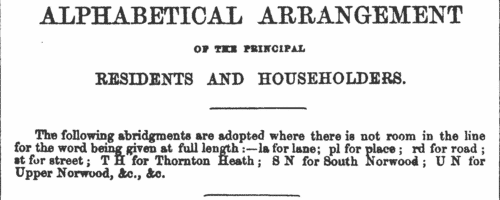
| Inhabitants of Gravesend
(1867)
The Fifteenth annual edition of Hall's Gravesend, Milton and Northfleet Directory and Advertiser includes these alphabetical general directories of Gravesend, Perry Street and Northfleet. | Sample scan, click to enlarge

| South Shropshire Poll Book: Pontesbury
(1868)
The poll book of the election, November 1868, for the Southern Division of Shropshire, is arranged by polling district, and then by parish, township, &c., showing the votes cast (H, Herbert; C, Corbett; M, More), the number on the electoral register, and the full name of the voter, surname first. Where a person had voting qualification in more than one parish, the name is given in each place, but with a cross-reference to the parish list with the entry the vote(s) cast. At the head of each column of register numbers there is a letter in bold indicating the polling district - A, Bishop's Castle; B, Bridgnorth; C, Church Stretton; D, Cleobury Mortimer; E, Clun; F, Ludlow; G, Pontesbury; H, Shiffnal; I, Wenlock. | Sample scan, click to enlarge
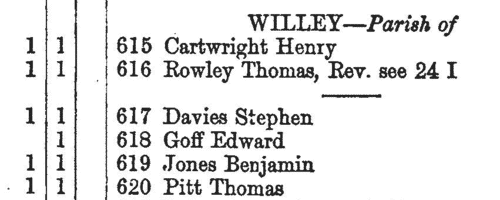
| Stockton-on-Tees Voters: Stockton Polling District
(1868)
This poll book for the First Parliamentary Election for the Borough of Stockton-on-Tees lists the voters alphabetically by polling district, with full name (surname first) and address. In the right-hand column D represents the Liberal candidate, Joseph Dodds, Esq., and V the Conservative, Lord Ernest Vane Tempest. The three polling districts were Norton, Stockton (including so much of Linthorpe as lay within the parliamentary borough of Stockton), and Thurnaby. At the end of each district the handful of lodger voters are listed separately. | Sample scan, click to enlarge

| Births: Girls
(1869)
Births of girls, reported in the Pall Mall Gazette, May 1869 | Sample scan, click to enlarge

| Members of the Association for Promoting the Extension of The Contagious Diseases Act, in Gravesend
(1869)
The Contagious Diseases Act of 1866 had as its first objective the establishment of isolation hospitals for the treatment of soldiers and sailors afflicted with smallpox, typhoid, measles, chicken pox, malaria, scarlet fever, bubonic plague, dysentery, enteric fever and other infectious conditions. This association was formed to lobby for the extension of the Act to the civil population of the United Kingdom. The membership was drawn not just from the medical profession and those interested in the administration of the poor law, but also from concerned individuals throughout society. The membership list was published alphabetically by area: the scan shows the start of the names for Leicester. | Sample scan, click to enlarge
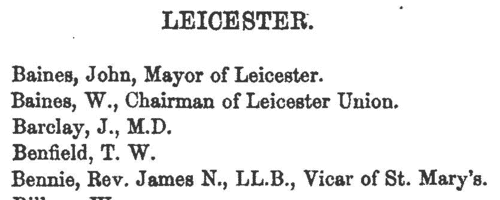
| Boys entering Leeds Grammar School
(1875)
The admission books for Leeds Grammar School from 1820 to 1900 were edited by Edmund Wilson and published in 1906. The series of registers is almost complete for the period, there being in addition admission registers for the Lower (or Commercial) Department from 1856 to 1865, and lists of boys in the school in 1856, and in the Commercial Department in 1861. The entries are arranged by date or term of admission: a sequential number is given first, then surname, christian name, and, after a dash, father's christian name, occupation, and address; another dash, and then the age of the boy at admission, and often his year of leaving (with the abbreviation r. for 'removed' or 'left'). r.* means left without notice; (o) or S. or Stranger or Foreigner indicates a boy not on the foundation. The editor was unable to divine the meaning of the abbreviation (Q) or the asterisks prefixed to most entries in 1856 to 1860, but dutifully copies them into the text. In smaller type he then proceeds, where possible, to add some information about the boy's subsequent career. | Sample scan, click to enlarge
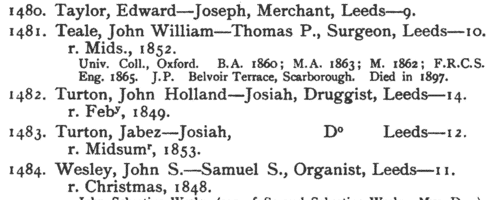
| Trainee Schoolmistresses in England and Wales
(1877)
The Education Department set examinations for candidates for admission into training colleges, and for the office of teacher. This is the list of successful female candidates from England and Wales at the examination at Midsummer 1877. The number in the first column shows order of merit in each class in the examination; then there is the name of the candidate (surname, christian name and any intermediate initial(s)), the school in which engaged, and the training college at which examined. The names of pupil teachers are shown in italics, with the 'school in which engaged' column left blank. These abbreviations are used in the names of schools: B., British; Bd., Board; Ch., Church of England; N., National; P., Parochial; R. C., Roman Catholic; U., Poor Law Union; W., Wesleyan Methodist. | Sample scan, click to enlarge
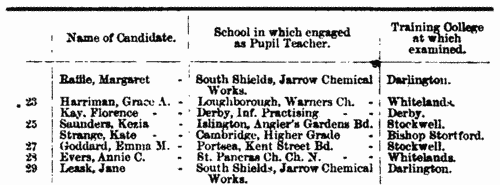
|
Research your ancestry, family history, genealogy and one-name study by direct access to original records and archives indexed by surname.
|











